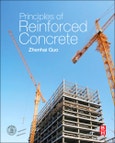Principle of Reinforced Concrete introduces the main properties of structural concrete and its mechanical behavior under various conditions as well as all aspects of the combined function of reinforcement and concrete. Based on the experimental investigation, the variation regularity of mechanical behavior, working mechanism, and calculation method are presented for the structural member under various internal forces. After examining the basic principle and analysis method of reinforced concrete, the book covers some extreme circumstances, including fatigue load, earthquake, explosion, high temperature (fire accident), and durability damage, and the special responses and analysis methods of its member under these conditions.
This work is valuable as a textbook for post-graduates, and can be used as a reference for university teachers and under-graduates in the structural engineering field. It is also useful for structural engineers engaged in scientific research, design, or construction.
Please Note: This is an On Demand product, delivery may take up to 11 working days after payment has been received.
Table of Contents
1 Introduction
Part One Mechanical Behavior of Concrete 2 Basic Mechanical Behavior 3 Behavior under Influences of Main Factors 4 Various Structural Concrete 5 Multiaxial Strength and Constitutive Relation
Part Two Combined Function of Reinforcement and Concrete 6 Mechanical Behavior of Reinforcement 7 Bond between Reinforcement and Concrete 8 Mechanical Behavior under Axial Force 9 Confined Concrete 10 Mechanical Response of Deformation Difference
Part Three Strength and Deformation of Structural Member 11 Strength of Member under Compression and Bending 12 Tensile Crack 13 Flexural Stiffness and Deformation 14 Strength of Member under Shear Force 15 Strength of Member under Torsion
Part Four Special Behaviors of Structural Members 16 Aseismic Resistance 17 Fatigue Resistance 18 Explosion Resistance 19 Fire Resistance 20 Durability
Appendix Exercise and Discussion








